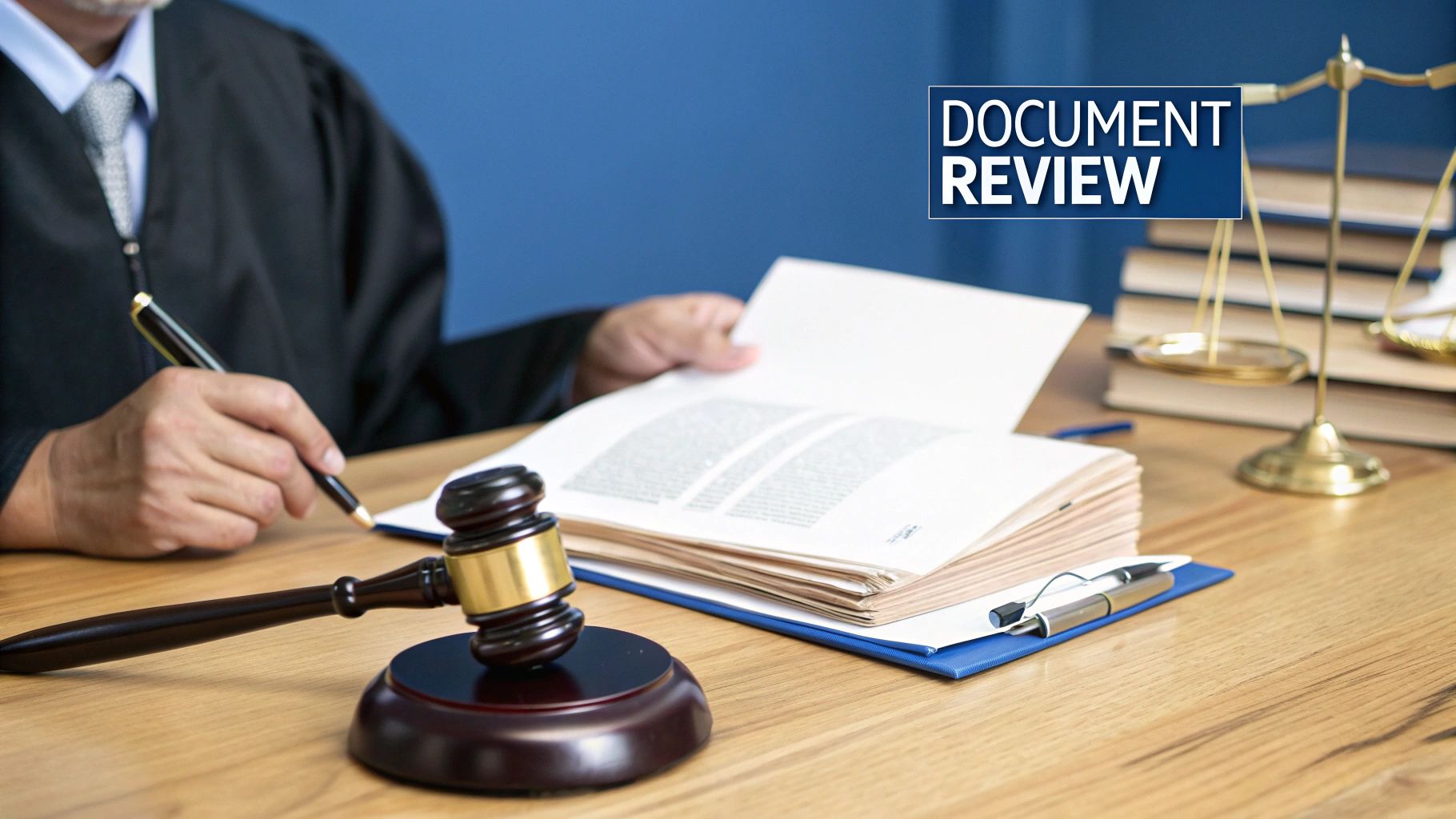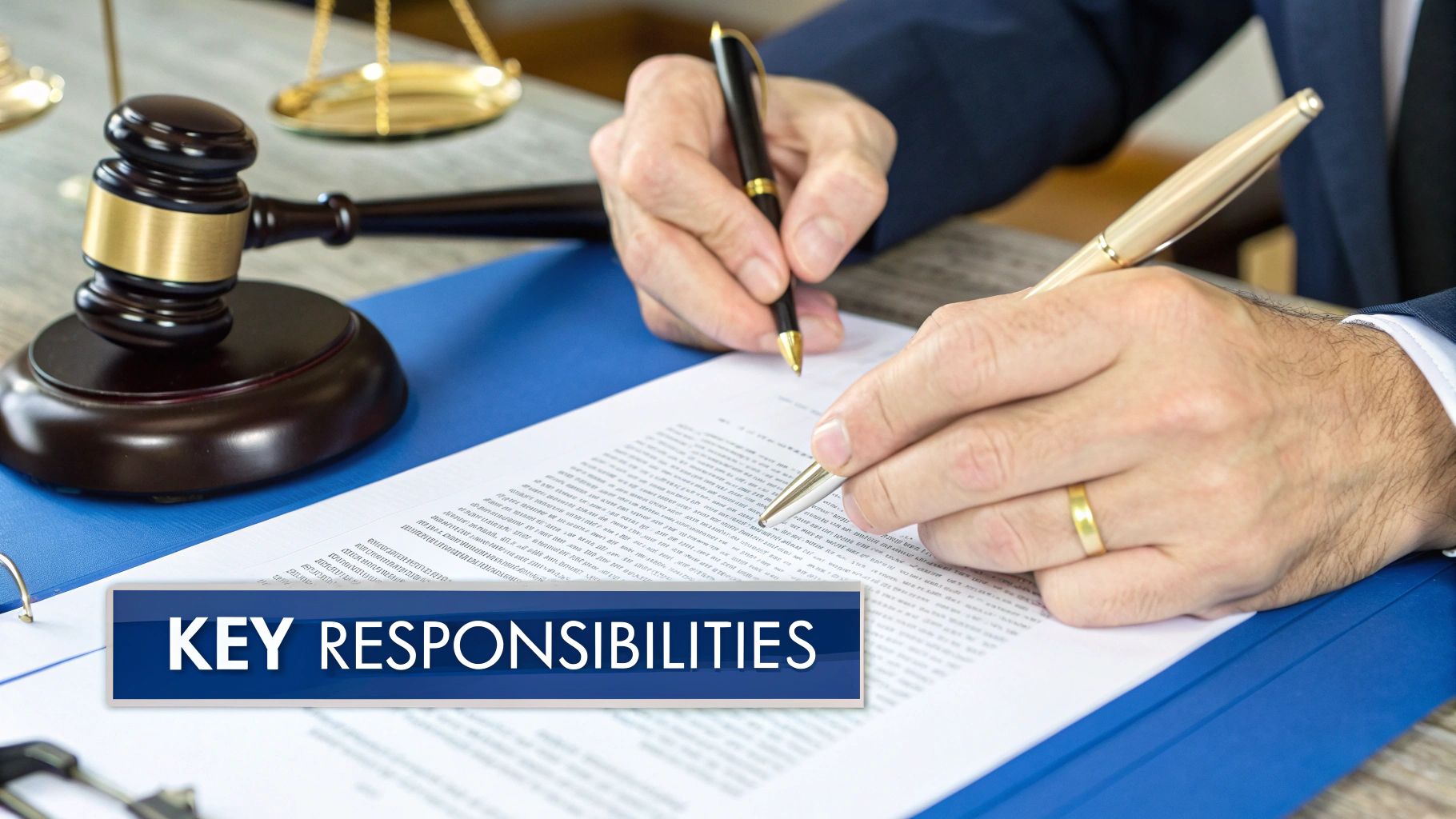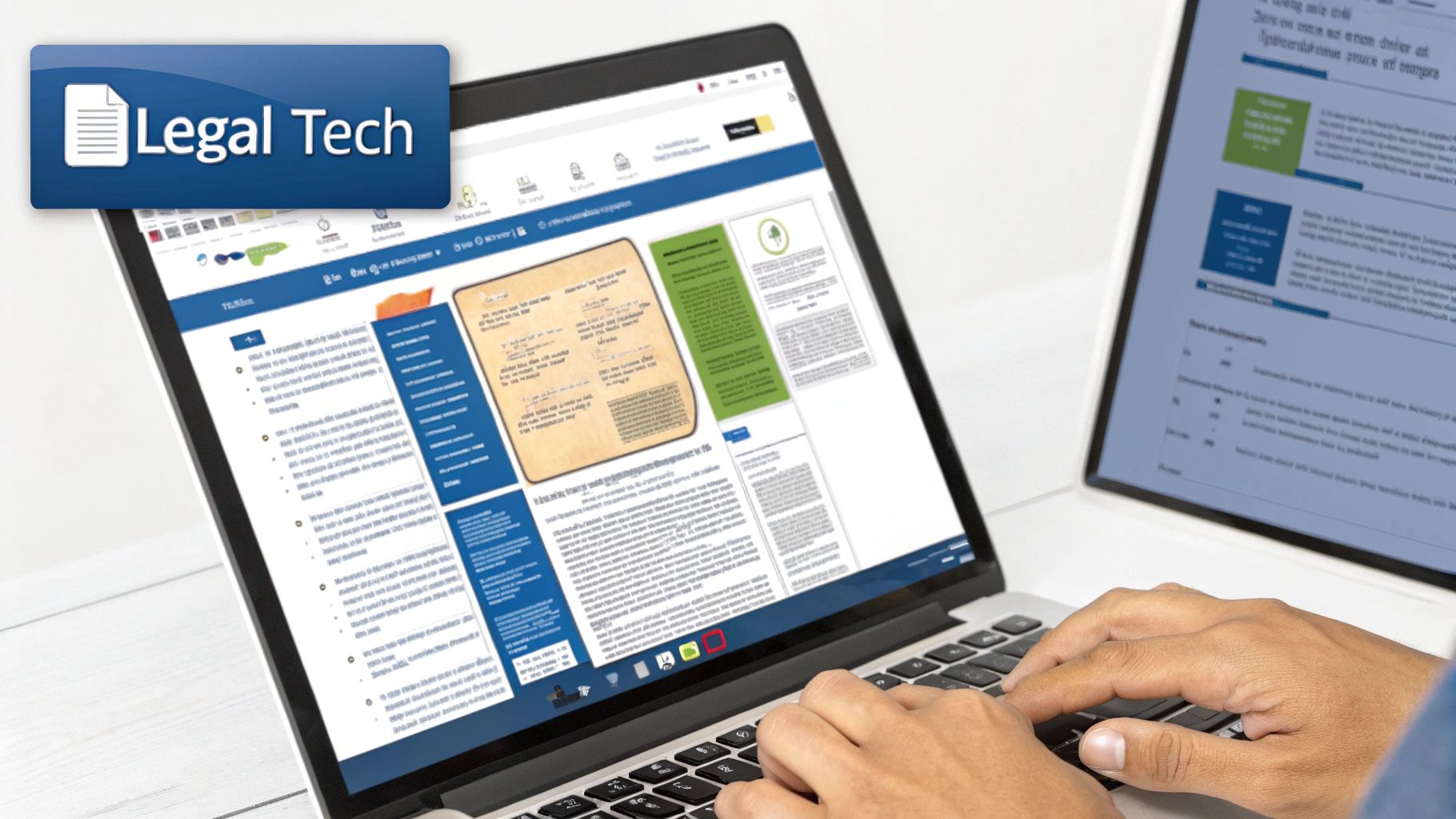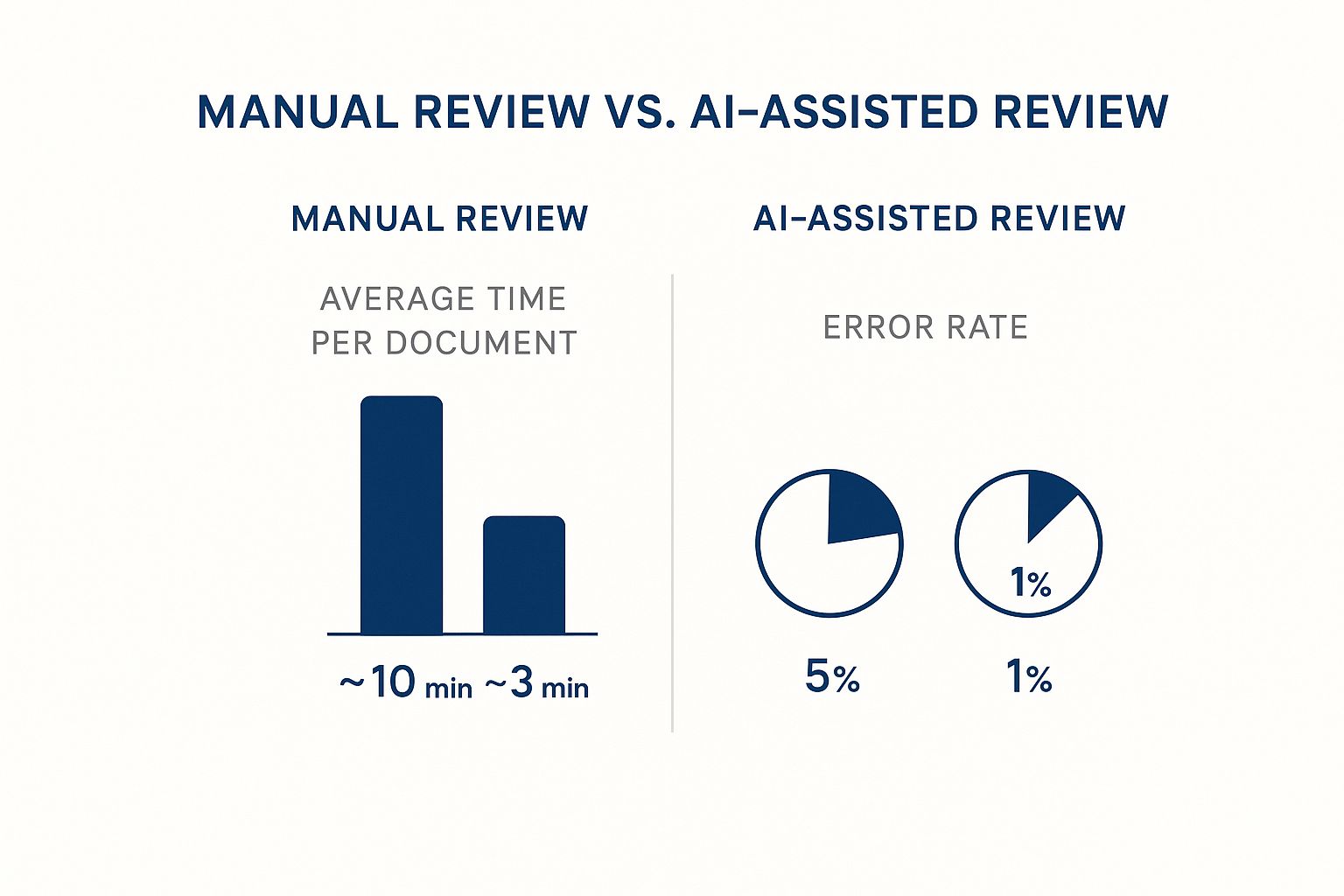The Modern Document Review Attorney Guide
At its core, a document review attorney is a legal detective for the digital age. They are the ones who dig through mountains of electronic information—everything from emails and text messages to spreadsheets and presentations—to find the crucial pieces of evidence needed for a lawsuit or investigation. It’s a role that has shifted dramatically from dusty file rooms to the complex world of data, demanding a unique mix of sharp legal thinking and tech-savvy skills.
What Exactly Is a Document Review Attorney

If you're picturing a lawyer buried under stacks of paper, it's time for an update. Today, document review attorneys are at the crossroads of law and technology, playing a critical part in the discovery phase of almost every legal matter. Their main job is to analyze Electronically Stored Information (ESI) and figure out what’s important to a case.
This isn’t just about running a few keyword searches. It’s about understanding the nuances of a legal argument to spot which documents are relevant, which are protected by privilege, and which contain confidential information. Imagine trying to find one specific email thread buried in a database of a million messages—that's the kind of challenge these attorneys tackle every day.
The Core Responsibilities
The day-to-day work of a document review attorney is incredibly focused. They are brought in to make consistent, legally sound judgments on huge datasets, often against a tight deadline. This work lays the factual groundwork for the entire legal strategy.
Some of their key tasks include:
- Relevance Coding: Going through documents one by one and flagging them as either responsive (relevant) or non-responsive to the case's legal requests.
- Privilege Identification: Pinpointing communications that are legally protected, like those between an attorney and their client, so they aren't accidentally turned over to the other side.
- Confidentiality Tagging: Marking sensitive business data, like trade secrets or private customer information, that needs to be handled carefully or redacted.
- Issue Spotting: Identifying the "hot docs"—those smoking-gun emails or memos that could completely change the direction of a case.
This process is far more than just sorting files. It’s about piecing together the story of a case from a chaotic mess of raw data. Each decision an attorney makes about a document directly influences what evidence will shape the outcome of litigation.
Moving Beyond Manual Review
The explosion of digital information has made reviewing every single document by hand simply impossible. A single corporate case can easily generate terabytes of data, which translates to millions upon millions of files. This data deluge has forced the legal field to adopt a tech-assisted approach.
A successful document review attorney today is just as comfortable using eDiscovery software as they are citing case law. More and more, this means working with AI-powered tools that can sort through the noise. These platforms don't replace the lawyer's judgment; they supercharge it, helping them focus their time and expertise on the most complex and important documents.
In essence, the role has evolved. These attorneys are now data strategists, using technology to get to the truth faster and more accurately. It’s this combination of legal skill and tech fluency that makes the modern document review attorney so essential. To get a better sense of how this all comes together, you can explore the complete document review process from start to finish.
A Day in the Life of a Document Reviewer

So, what does a document review attorney actually do all day? It's a highly structured and often intense process, mixing deep focus with quick, collaborative problem-solving. This isn’t mindless clerical work. Think of it as the intellectual engine room of modern litigation, where mountains of raw data are sifted and shaped into the evidence that wins cases.
Let's say you're on a team tackling a massive corporate fraud case. Your day won't begin by just jumping into a random pile of files. It all starts with the project briefing—a critical meeting that sets the stage for the entire review and gets everyone on the same page.
The Morning Briefing and Setup
The day kicks off with a senior attorney or project manager laying out the case's key facts, legal arguments, and the specific goals of the review. This isn't just a quick summary; it's the strategic roadmap. Here, you'll be walked through the "coding protocol" or "review manual," which is essentially the rulebook for the project.
This manual is everything. It precisely defines what makes a document relevant, privileged, or confidential. With a team of dozens—sometimes hundreds—of attorneys working on the same set of millions of files, this protocol ensures everyone makes consistent calls. That consistency isn't just good practice; it's legally defensible in court.
Diving into the Digital Trenches
Once the briefing is over, you log into the eDiscovery platform. This is your command center, a secure software environment where all the case documents live. The system serves up documents one by one—emails, spreadsheets, presentations, chat messages—and your job is to apply digital "tags" based on the rules you just learned.
This is where the real concentration kicks in. For each and every file, you have to make a swift but careful judgment call:
- Is it Responsive? Does this document actually relate to the legal claims or the specific time frame of the lawsuit?
- Is it Privileged? Is this a confidential communication between a lawyer and their client? If so, it needs to be protected.
- Is it Confidential? Does it contain sensitive information like trade secrets or personal data that requires special handling?
You might click through hundreds, or even thousands, of these documents in a single day. Each one requires a split-second legal assessment.
"Every tag, every decision, is a building block in the case. A single miscategorized email could inadvertently waive privilege or hide a crucial piece of evidence, with significant consequences down the line."
Collaboration and Quality Control
Document review is rarely a solo mission. Throughout the day, you’ll inevitably run into documents that are ambiguous or incredibly complex. When a file doesn't fit neatly into any of the predefined categories, you don't just guess. You escalate it.
This means flagging the document for a senior reviewer or a subject matter expert who has the final say. This escalation process is a vital part of quality control (QC). On top of that, a percentage of every reviewer's work is typically double-checked by a second-level reviewer to catch any errors and ensure everyone is still on the same page. This QC loop is what makes the final work product defensible against challenges from the opposing legal team. These systems are part of a broader strategy for effective document management for law firms, making sure every piece of data is handled correctly.
Since many document review jobs are now remote, knowing how to stay focused and productive is essential. Following solid remote work best practices helps you keep up with the demanding pace, no matter where you're working. Ultimately, a reviewer's day is a disciplined cycle of analysis, judgment, and verification—the critical work that turns a chaotic mess of data into a coherent legal narrative.
The Skills That Define a Top-Tier Review Attorney

What separates a good document review attorney from a truly great one? It’s a powerful mix of old-school legal instincts and modern tech fluency. Simply knowing the law isn’t enough anymore, and neither is being a whiz with software. The real pros are the ones who can weave these two worlds together.
Think of it this way: the best attorneys in this field are like master translators, fluent in both the language of law and the language of data. Their value comes from bridging that gap. This expertise really boils down to two key areas: timeless legal skills and the technological competence that today’s work demands.
Foundational Legal Acumen
Long before you log into any review platform, the most critical tools are your own legal knowledge and analytical mind. These are the uniquely human skills that software can’t quite replicate. They’re what allow an attorney to spot the subtext, nuance, and human element hidden within a mountain of documents.
At its core, this foundation is built on a few key abilities:
- Obsessive Attention to Detail: In document review, the devil is always in the details. A single misplaced word, an overlooked date, or a subtle change in tone can completely alter a document's meaning. The best reviewers can spot these tiny but crucial elements, even on document number 5,000.
- Sharp Analytical Reasoning: This is about more than just reading words on a page; it’s about connecting the dots. A skilled reviewer can take an email, a memo, and a spreadsheet and see how they fit together to tell a larger story—understanding not just what’s said, but what’s implied.
- Rock-Solid Grasp of Legal Principles: A deep understanding of concepts like attorney-client privilege, the work product doctrine, and confidentiality is non-negotiable. One wrong call on privilege can have catastrophic consequences for a case, potentially waiving vital protections.
A computer is great at finding a keyword. But it can't detect sarcasm in an email, figure out what someone meant in a hastily written message, or understand the importance of what’s left unsaid. That’s where a lawyer’s judgment is still king.
Technological Competence and Adaptability
The other side of the coin is pure technological skill. In an era dominated by Electronically Stored Information (ESI), knowing your way around review software is just as critical as knowing the rules of evidence.
This isn’t just a trend for big firms, either. The 2025 Legal Outlook Survey from Best Lawyers found that firms of all sizes are leaning heavily on technology to get through massive document loads. From small practices (23.86% of those surveyed) to the largest firms (26.6%), tech skills have become a universal job requirement. You can explore more about how the industry is shifting in the full 2025 legal profession outlook.
Here are the essential tech skills for any modern reviewer:
- Mastery of eDiscovery Platforms: You need to be truly proficient with tools like Relativity, Disco, or Everlaw. This goes way beyond just clicking "responsive" or "not responsive." It means knowing how to build complex searches, use advanced filters, and organize data efficiently to speed up your workflow.
- Understanding of Technology-Assisted Review (TAR): Top-tier reviewers need to understand how TAR and predictive coding actually work. You don’t need to be a data scientist, but you do need to know enough to help "train" the AI and confidently validate its results. You can read more about how this works in our guide to modern legal research methods.
At the end of the day, the most sought-after professionals are those who see AI not as a replacement, but as a powerful partner that makes their own expertise faster and more accurate.
Navigating the New World of Digital Evidence
The days of sifting through neat stacks of printed emails are long over. Today, the biggest hurdle for any document review attorney is the sheer chaos of modern communication. Business conversations aren't tucked away in simple email attachments anymore; they're fragmented across platforms like Slack, Microsoft Teams, and WhatsApp.
This digital sprawl has created a minefield of potential evidence, introducing new forms of data that are a nightmare to review out of context. We're talking about emojis, GIFs, edited messages, voice notes, and even disappearing messages. Each one is a puzzle, and its meaning is completely dependent on the surrounding conversation—a context that's easily shattered when you pull the data out of its original home.
The Problem with Modern Communication Data
Think about the fast-paced, back-and-forth nature of a typical chat. It’s a rapid-fire exchange of text, reactions, and threaded replies. A single thumbs-up emoji could mean anything from "I agree" to "Got it" or even a sarcastic dismissal, depending on what came before and after.
Likewise, an edited or deleted message could be a simple typo fix, or it could be a deliberate attempt to hide something crucial. Stripped of their conversational flow, these data points become almost meaningless. This is the central challenge for a review attorney: piecing together a coherent story from scattered fragments while ensuring the process is accurate and defensible, all under crushing deadlines.
Imagine reviewing a Slack thread where a key message was deleted. The review platform might only show "[message deleted]," but the surrounding replies discussing that original message are still visible. It's the attorney's job to piece together what was said and why it might have been removed.
The pressure to manage this flood of data is immense. In 2025, the challenges are only growing as the volume and complexity of electronically stored information (ESI) continue to explode. ESI has been part of legal discovery for two decades, but the recent explosion of communication channels has changed the game.
To see just how much things have changed, it's helpful to compare the old world of ESI with the new.
Traditional vs Modern ESI Challenges
| Feature | Traditional ESI (e.g., Emails, Word Docs) | Modern ESI (e.g., Slack, Teams, WhatsApp) |
|---|---|---|
| Structure | Linear, static, and self-contained documents. | Dynamic, fragmented conversations with threads. |
| Content | Primarily text-based. | Mix of text, emojis, GIFs, reactions, voice notes. |
| Context | Contained within the document or email chain. | Dependent on the entire channel or chat history. |
| Integrity | Relatively easy to preserve as a single file. | Challenged by edits, deletions, and disappearing messages. |
| Review Difficulty | Straightforward; review one document at a time. | Complex; requires reconstructing conversational flow. |
This table really highlights why old review methods just don't work anymore. The conversational, often chaotic, nature of modern ESI requires a completely different approach to maintain accuracy.
The High Stakes of Context and Security
Losing context isn't just an inconvenience; it can torpedo an entire case. Let’s say an executive sends a message in a contract negotiation: "I'm fine with the terms." Hours later, after learning new information, they add a thumbs-down reaction to that same message. A linear review tool might display this as a confusing, contradictory entry. But in its native platform, the timeline makes the executive's change of heart perfectly clear, fundamentally altering its legal importance.
This is why the security and integrity of this data are absolutely critical. Attorneys are constantly handling extremely sensitive client information across these platforms, making a rock-solid security posture non-negotiable. Protecting that data is a core responsibility, and our guide on law firm data security dives deep into the best practices for keeping it safe.
The good news is that technology is catching up, giving attorneys a fighting chance to manage this data.

As this shows, AI-powered review tools don't just speed things up; they also slash the error rate, making the process faster and more reliable. Of course, as we lean more on technology, understanding the rules of the road is key. It's also important to stay current on topics like the legality of data collection practices like website scraping to ensure all data is handled ethically and legally.
How AI Is Reshaping the Document Review Field
Talk of artificial intelligence in the legal world seems to bounce between two poles: it's either a silver bullet for everything or a robot coming for your job. For the modern document review attorney, the truth is far more practical and, frankly, more interesting. AI isn't an opponent; it’s quickly becoming a crucial partner, transforming the job from a manual grind into a strategic, tech-forward discipline.
Picture AI as the most efficient junior associate you could ever imagine. Its main role is to tear through the initial pass of a massive document set with unbelievable speed and consistency. This first cut, which used to burn thousands of human hours, can now be done in a tiny fraction of the time. This frees up human attorneys to do what they’re actually trained for.
This shift means legal professionals can finally move past the repetitive click-work of marking documents "relevant" or "not relevant." Instead, they can focus their mental energy on higher-value tasks: digging into the key documents the AI has surfaced, running tight quality control, and actually building the narrative of the case.
From Manual Sorter to Tech-Enabled Strategist
This new partnership between people and machines is driven by technologies like predictive coding and Generative AI. Predictive coding, a type of Technology-Assisted Review (TAR), is a smart system. It watches how senior attorneys code a small sample of documents and then applies that same logic across the entire dataset, pushing the most important files to the top of the pile.
Generative AI kicks things up another notch. It doesn't just sort; it can summarize lengthy documents, pinpoint specific concepts, and even answer direct questions you ask about the data. An attorney could, for instance, ask the system to "find all communications discussing the project's budget overruns in Q3," and the AI can pull up the relevant files in seconds.
This creates a much smarter workflow:
- AI First Pass: The AI platform does the heavy lifting, reviewing millions of documents to flag and categorize anything potentially relevant based on the criteria you've set.
- Human Analysis and QC: The document review attorney then works with a much smaller, pre-vetted set of documents. Their job becomes about verification, applying nuance, and providing critical oversight.
- Deeper Insights: When you're not drowning in a sea of documents, you can start to see the bigger picture. Attorneys can spot connections and patterns that were impossible to find when buried in the data.
This isn't about replacing human judgment—it's about amplifying it. The AI handles the "what," finding the documents that fit the search. The attorney provides the "why," understanding the context, the importance, and what that information means for the case.
The New In-House Reality
This technological shift isn't just changing how one attorney works; it's rearranging the entire industry. The old model of shipping massive review projects off to third-party vendors is starting to look very dated.
By 2025, Generative AI is expected to have a huge impact, especially in major legal markets. In 2024, many of America's largest law firms started using GenAI for first-level review after seeing it could analyze huge datasets faster and more accurately than human teams. This initial success is chipping away at old doubts about AI's reliability and security. The result? Firms are bringing this work back in-house, using AI platforms to automate the first stages and save a ton of time and money. You can read more about this shift and the future of document review on eDiscovery Today.
The Empowered Attorney
At the end of the day, AI empowers the document review attorney to deliver much more value. By automating the most tedious parts of the job, it allows them to operate at a higher level, focusing on complex legal analysis and strategic thinking. The role is changing from data reviewer to data interpreter—a legal professional who can not only find the smoking gun but also explain exactly what it means for the case.
This blend of human expertise and machine intelligence is the future of the profession. For attorneys ready to adapt and embrace these tools, the career is becoming more intellectually challenging and strategically vital than ever. To see how these tools fit into the bigger picture, check out our strategic guide to using an AI legal assistant in a modern law practice.
Answering Your Questions About This Career Path
If you're thinking about a career as a document review attorney, you probably have some practical questions. What does the day-to-day really look like? How do you get paid? And is this a stable, long-term career choice? Let's break down some of the most common questions people have.
What's the Typical Career Path?
Very few people jump straight into a senior, permanent role. The journey usually starts with contract projects. This is actually a great way to get your feet wet, giving you hands-on experience with different eDiscovery platforms and all sorts of case types. Your main goal in this phase is to build a reputation for being accurate and efficient.
Once you’ve got some experience under your belt, the path starts to open up. You might move into roles like:
- Review Team Lead: Here, you’re managing a small group of reviewers, running quality control checks, and acting as the go-to person for the project manager.
- eDiscovery Project Manager: This is a bigger-picture role. You oversee the entire review from start to finish—managing the budget, setting timelines, and choosing the right tech for the job.
- Legal Tech Consultant: You could find yourself advising law firms or corporate legal teams on their whole eDiscovery strategy and helping them roll out new tools.
Getting ahead really comes down to a mix of solid legal instincts and strong tech skills. If you can master both, you’ll find doors opening to permanent positions in law firms or corporate legal departments, where you can specialize in litigation support and information governance.
How Is Compensation Usually Structured?
How you get paid as a document review attorney can look very different depending on the job. If you’re working on a contract or temporary basis, you’ll almost always be paid by the hour. Those rates can swing quite a bit based on how complex the project is, where you're located, and whether you have special skills, like fluency in a foreign language.
On the other hand, permanent, in-house jobs at law firms or corporations come with a standard salary and benefits package. As AI gets better at handling the initial, more routine reviews, the pay structure is starting to change. Attorneys who know how to manage the technology, perform sophisticated quality control, and guide the overall strategy are the ones who can command higher pay. Your value isn't just in clicking through documents anymore; it's in mastering the entire tech-assisted review process.
The market is shifting to reward value over volume. An attorney who can skillfully guide an AI-driven review to unearth key evidence quickly is far more valuable than one who can manually review thousands of documents.
Is Document Review a Viable Long-Term Career?
Yes, but there’s a big "if" attached: it’s a viable career for those who are willing to adapt. The future of document review belongs to professionals who see AI as a partner, not a replacement. The days of spending all your time on purely manual, one-by-one document review are coming to an end.
The attorneys who will succeed long-term are the ones who lean into developing the strategic and analytical skills that a machine just can't replicate. By embracing technology and positioning yourself as an expert at the intersection of law and data, you can build a stable, interesting, and rewarding career. It’s a unique chance to be on the front lines of innovation in the legal field.
Ready to make your document work faster and smarter? Whisperit uses advanced AI to help legal professionals create, edit, and manage documents up to two times faster, all while maintaining the highest standards of security. Learn how you can transform your workflow at whisperit.ai.